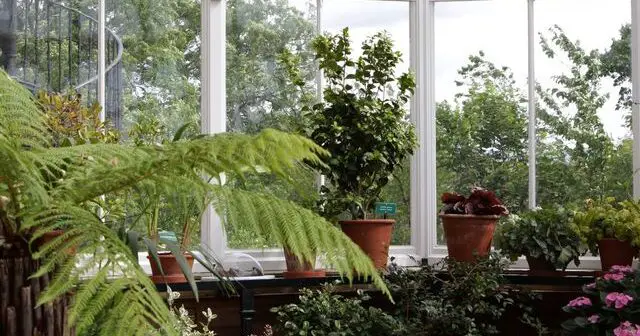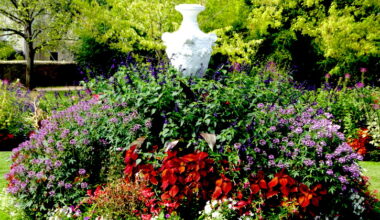Creating a small indoor garden in a porch is a luxury that cannot be improvised. For the plants and flowers in a porch to flourish, you have to choose them well. Here is a list of plants that will fit perfectly in your unheated porch!
Contents
14 plants for an unheated porch
1. The prickly pear tree
Here is one of plant which will give greenery… and spice to your porch! The prickly pear tree likes the light and warmth found under the porches. You can recognize the prickly pear tree by its rounded leaves, almost like tennis rackets that do not sting, for a cactus plant, it’s not bad! It flowers from June to September.
2. The livistona
It has very green, hand-shaped leaves. The livistona is a plant which will be liked in the porches. It likes the luminosity, but if you take care not to leave it too much in full sun. It likes the light, but hates the sun rays.
3. Bougainvillea
This climbing plant which gives beautiful bunches of pink and purple flowers loves the sun. This one, you will be able to put it in full exposure so that it feels good. In the hot regions one can also plant it in full ground. Bougainvillea is an ideal plant if your porch is exposed to the south.
4. The lemon tree
Beware because if the lemon tree likes it in your porch it can reach several meters in height! Small tree with oval, glossy leaves, persistent like most citrus trees, it produces year-round bouquets of fragrant white flowers followed by edible fruit.
The lemon tree is a plant that can be planted in the ground in southern regions, but elsewhere, it is better to plant it in a container, preferably in a special citrus soil. It is necessary to reserve a very luminous but not artificially heated room, the porch will be ideal.
5. Ferns
Boston ferns are easy to maintain. Ferns in general are excellent plants for the porch that like shade. Although Boston ferns are perfect in the shade, if you have sunny areas, the Kimberly Queen fern would be a better choice because it tolerates a little sun. Other recommended varieties are the Asparagus Fern and the delicate Maiden Hair Fern. These are nice additions to shade pots.
6. Coleus
It gives color through its leaves, it is robust and can be used alone or mixed with other plants. These plants for the porch are known for their colorful foliage. They can live in a pot or around trees or shrubs.
7. Begonias
There are many varieties of begonias. They are colorful (leaves and flowers), require little maintenance and do not require as much water as other plants. Almost all begonia varieties should perform well in shade pots.
8. New Guinea Impatiens
Garden experts recommend all New Guinea Impatiens for shade and sunny areas. The common impatiens, which were so popular in recent years for shade, have fallen into disgrace because of the mildew that plagued them. New Guinea resists this and is a hardy variety with larger, more conspicuous flowers.
9. Caladium
Caladiums, with their heart-shaped colored leaves, are rather carefree once planted, according to experts. They are tubers and spread well.
10. Lantana
He is the one that all plant experts consider as a sun lover. It is ideal for hot spots because it is drought resistant. The colors of lantana are pretty too, with yellow, a little lavender and white. Put in a large pot of dwarf Alberta spruce in the middle, surrounded by sun loving flowers such as the lantana plant, which tends to spread out. Another colorful combination for sunny areas is red salvia in the middle of a pot, surrounded by a yellow lantana. It looks great and you will have color until October and November.
11. Petunias
Petunias are among the most popular annual plants for good reason. They are bright and lively, bloom from spring until frost and perfume the air. Best of all, petunias are incredibly easy to grow, both in the garden and in pots.
12. Marigolds
A large marigold pot provides lots of color and is easy to maintain. In addition, they have the added advantage of being able to repel insects that can harm other plants.
13. Tropical plants
The plants for the porches, such as Mandevilla and Hybiscus, are resistant to the sun. They provide a lot of color and last all season with little or no maintenance other than watering.
14. Autumn Joy’ Purple Spruce
If you are looking for the most sustainable solar plant, this perennial is your best choice.
Plants adapted to the orientation of the porch
Most often, the porch is oriented south-east to south-west for maximum light, which can be tempered in summer with blinds or shutters and good ventilation.
The plants in the porch are therefore mostly full sun plants.
This great luminosity allows for generous flowering and even fruiting that is difficult to obtain in the house.
Plants fearing frost and winter humidity
Even unheated, the porch is a space open to the inside that usually benefits from the warmth of the house. It protects plants from frost and excess winter humidity.
This gentle warmth can be maintained at the desired temperature by an auxiliary heater equipped with a thermostat, especially if it houses exotic plants of tropical origin that hate temperatures below 59°F. If porch life is successful for tropical plants, take care to control their growth or you may feel suffocated.
A citrus fruit porch
Citrus fruits enjoy an unheated porch where they appreciate the brightness, the protection from frost in cold regions or the dry air of the interiors. Calamondin, kumquat or lemon tree will embalm the porch with their many fragrant flowers.
Water them with non-lime-sensitive water. Repot only when they are really cramped for more flowers and therefore more fruit!
Some tips for an unheated porch
- Use demineralized water or rainwater for all spraying in canopies. This will prevent the glass from staining with limescale, reducing the light available for plants;
- Be careful that the burning rays of the sun do not burn the foliage of your plants, shade during the hottest hours of the day with blinds or sun curtains ;
- Refresh your porch by wetting the floor (preferably tiled) every morning, because the temperature tends to rise quickly;
- Ventilate the conservatory as soon as the outside temperature allows it to avoid a feeling of permanent dampness;
- The depolluting plants have shown in laboratory studies the ability to capture air pollutants in their tissues. However, this capacity has not been scientifically proven in real-life situations*.
- In winter, reduce watering (never more than once a week) and stop spraying.
Summary
If you are lucky enough to own a porch, turn it into a conservatory. So, even in the middle of the bad season, relax amidst the lush greenery and foliage of tropical plants. In a greenhouse heated in winter, don’t deprive yourself of exotic plants and their spectacular flowering!
In this room, an extension of the house on the garden, or in your greenhouse, the brightness is the strongest. It is in this place that the plants that spend the summer outdoors overwinter. It is also here that you will be able to benefit from flowering and fruiting out of season (if the room is a heated minium).









